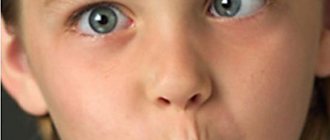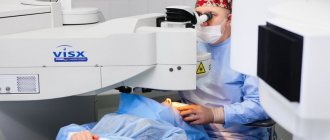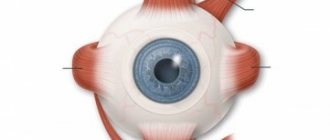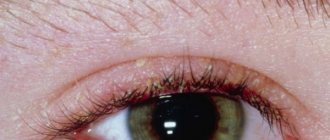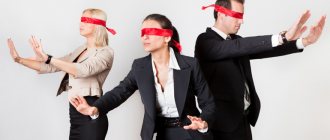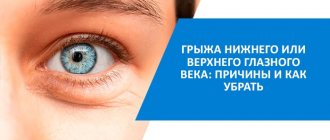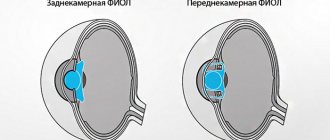Causes of strabismus
The most common cause of strabismus is heredity. About 30% of children with strabismus have a family member with a similar defect.
Other etiological factors:
- Cerebral paralysis;
- Down syndrome;
- Hydrocephalus;
- Multiple sclerosis;
- Diabetes;
- Brain tumors;
- Uncorrected farsightedness;
- Stroke;
- Complications of ENT infections;
- Ophthalmological pathology (retinal detachment);
- Head injuries;
- Neurological disorders;
- Graves' disease.
The position of each eyeball is maintained by six extraocular muscles. They receive their innervation from the 3rd, 4th and 6th cranial nerves and move it in different directions.
| Extracular structures have certain characteristics and mechanisms of morphogenesis that are unique to mammals. During the prenatal period, the formation of these muscle fibers is mainly determined by genetic regulatory factors, and it is largely dependent on the development of motor neurons in the brain centers. In the postnatal period, their final structure is established under the influence of epigenetic regulatory stimulators, that is, growth factors, hormones and cell adhesion molecules. There is a critical time for their development, which lasts from 3 to 6 months after birth, during which the extraocular fibers acquire the specific structure and function necessary for stereoscopic perception. |
With this nosology, the displacement of one or both eyes leads to the fact that the visual axes on the fixing object do not intersect. As a result of this, simultaneous merging of two monocular images does not occur in the centers of the cortical structures of the central nervous system. A person does not have a clear and single image; he sees a double or blurry object. This quite often leads to confusion and difficulty in performing many tasks in everyday life.
Diplopia can be a sign of a serious neurological condition such as traumatic brain injury, meningitis, or stroke. The central nervous system tries to protect itself from double vision and therefore constantly suppresses the pathological signals that come from the mowing organ. The result of this aggressive “suppression” is amblyopia. It is characterized by a functional decrease in visual acuity, in which the squinting organ is partially or completely excluded from the process of visual gnosis.
Risk factors for the manifestation of ocular dysfunction are prematurity, disturbances in the central nervous system, low birth weight, genetic predisposition and refractive error.
In some cases, the disease may be iatrogenic. This dysfunction is caused by traumatic damage to oculomotor fibers during operations on the lens and retina.
What is strabismus
This is a pathology found in ophthalmology and characterized by deviation of the cornea of the eye from the central axis. In medicine it is also called strabismus. In the normal state, when the eyes are positioned symmetrically, the image falls on the central axis, forming a single binocular image. With strabismus, the visual axes become asymmetrical, and the position of the visual organs is disrupted.
In people with strabismus, the eyes look in different directions, as a result of which the brain receives 2 different images, manifested as a split. Trying to normalize visual function, the central nervous system excludes the picture seen by a squinting eye, provoking the development of amblyopia (lack of functioning of one eye).
Classification
According to the timing of occurrence, pathology is of two types: congenital and acquired.
Sometimes the acquired form can progress against the background of cataracts, retinal detachment, leukoma (cataract), degenerative changes in the macula, and optic nerve atrophy.
The disorder can be periodic (transient) or permanent. According to the degree of development, it can be hidden, compensated, subcompensated and decompensated.
Towards:
- Internal rotation (esotropia);
- Eversion (exotropia);
- Upward tilt (hypertropia);
- Downward rotation (hypotropia).
Based on the reason for their occurrence, it is customary to distinguish between friendly (convergent and divergent) and paralytic non-friendly deviation.
Concomitant strabismus
Concomitant strabismus is characterized by equal deviation angles and the absence of diplopia, despite failures in stereoscopic perception.
The latent type (heterophoria) does not appear constantly, but periodically under certain circumstances, such as fatigue or intoxication. Heterophoria occurs in more than 70% of the population.
Paralytic disorder is caused by various neurological disorders. It is observed with paralysis of the cranial nerves (oculomotor, trochlear, abducens), as well as with paresis of the oculomotor bundles. Quite often, this type of illness is caused by traumatic injuries, infectious processes in the central nervous system (meningitis, encephalitis), malignant neoplasms (retinoblastoma), etc.
Exercises for strabismus
The tasks of eye gymnastics for strabismus (myopia, farsightedness and other types of vision deviations) include: complete relaxation of the eye muscles, focusing the gaze on one point, combining two pictures. If at the final stage it was possible to achieve the combination of two pictures, then we can talk about victory over strabismus.
Each of the exercises below should be repeated at least 16 times..
- Extend your hand forward and fix your gaze on your index finger. Bring your finger closer to your eyes, without looking away, and remove it. Repeat the same thing, lowering your hand down and raising it up.
- Move your eyes as far as possible to the left - right, then up - down, drawing figure eights with your gaze.
- Follow moving objects with your eyes, for example, a ball when playing ping pong.
- Look into the distance for a long time, through the window. Then focus your gaze on nearby objects.
- Stand with your back to the sun, cover your healthy eye with your palm. Then turn your head towards the squinting eye until it sees the sun's rays. Return to the starting position and start moving again in the same rhythm (at least 10 times). There is no need to turn your whole body or jerk your head, because the purpose of the training is to treat the eye, and not to strengthen the muscles of the body.
- If your left eye squints toward the bridge of your nose, close your healthy right eye. Move your right leg forward and reach your toe with your hand. After this, bend over and raise your arm as if pointing to the sky on the left side of your body.
- If your left eye is squinting towards your temple, move your left leg forward and reach with your right hand towards the toe of your left foot. Point your hand to where the affected eye should turn. If your right eye is squinting, you should put your left leg forward. Tilts are necessary to enhance blood movement in the eyeballs.
How to treat strabismus in adults, see the following link.
A necessary condition for obtaining the effect of eye exercises is their regular implementation.
Symptoms
This disease can be determined even without the help of a specialist. Clinical features and manifestations depend on the cause of occurrence.
With the paralytic type, the eyeball cannot deviate towards the paralyzed muscle, or this movement is very limited. In this case, parallel clinical symptoms are observed: sudden dizziness, doubling of the image, difficulty determining the distance to an object, difficulty reading and writing.
To functionally compensate for the work of the mowing organ, the patient periodically turns or tilts his head. These actions are necessary to ensure that the image falls directly on the retina, and only in this case does diplopia disappear. A person constantly bumps into things because depth perception is impaired.
Treatment
With strabismus, the ability to see normally is usually retained only by the eye that performs vision. An eye that squints to the side sees worse and worse over time, its visual functions are suppressed. Therefore, it is important to start treatment as early as possible.
Treatment of strabismus involves an integrated approach and may include:
- optical correction (glasses, lenses);
- treatment of amblyopia of the eye using hardware procedures;
- development of binocular vision;
- consolidation of achieved monocular and binocular functions;
- surgery.
Surgery is used mainly to achieve a cosmetic effect, since by itself it rarely restores binocular vision. The surgeon determines the type of operation directly on the operating table, since here it is necessary to take into account the peculiarities of the location of the muscles in a particular person. One or both eyes are operated upon. Surgery is aimed at strengthening or weakening one of the muscles that moves the eyeball.
The operation to correct strabismus is performed in one day under local drip anesthesia. The recovery period takes about a week, but after such a surgical operation, doctors recommend a course of hardware treatment for optimal restoration of visual functions.
Diagnosis of strabismus
The doctor makes a diagnosis only after a comprehensive examination of the patient, as well as a careful study of the medical and family history of the disease.
The main examination methods are: visual acuity testing, fundoscopy or funduscopy, ophthalmological examination (including cornea, sclera, conjunctiva, iris and lens) and mobility testing using various tests (for example, Cover Test and Hirschberg test).
In case of paralytic forms, urgent consultation with a neurologist or neurosurgeon is necessary, as well as additional examination methods (MRI, electromyography, electroneurography, EEG and others).
In case of thyroid dysfunction, consultation with an endocrinologist, ultrasound, and blood tests for hormones are carried out. If neuroblastoma is suspected, a consultation with an oncologist is scheduled.
Diagnostics
Detection of the disease involves a set of measures:
- collection of family history;
- examination of the organs of vision;
- strabismus test;
- biometric studies;
- study of refraction;
- determination of viewing angles;
- measurement of the volume of accommodation.
When collecting anamnesis, the doctor records the diseases suffered by the child and the presence of strabismus in the patient’s adult relatives. During a visual examination, the ophthalmologist pays attention to the converging eyeballs and the symmetry of the face. Consultation with a neurologist is necessary for paralytic strabismus.
Biometric studies reveal the anatomical features of the eyes.
During the diagnosis, visual acuity is checked using corrective glasses. The functionality of the eyeball is determined using hardware methods. These include:
- Skiascopy (shadow test) and refractometry are performed to study clinical refraction.
- A test with covering the eye is necessary to determine the quality of binocular vision, visual angle, accommodation characteristics, and convergence.
- Using biomicroscopy and ophthalmoscopy, transparent media and the fundus of the eye are examined.
Treatment of strabismus
- Modern methods of treatment:
- Specialized exercises;
- Computer programs;
- Special prismatic glasses and lenses;
- Pharmacological drugs (for example, botulinum toxin);
- Hardware correction;
- Occlusion: used in children with amblyopia to stimulate the deviating eye;
- Surgical procedure.
To choose the most effective method, ophthalmologists carefully study the type and severity of nosology. When choosing a correction method, the age, health status of the patient and the degree of imbalance must be taken into account.
Therapy in children should begin at an early age, since untimely correction can lead to visual and psychological difficulties.
Conservative therapy takes a long time, but it is more reliable. Surgery should be used when other methods have been used unsuccessfully.
How to correct strabismus at home
Strabismus therapy involves an integrated approach, constant medical supervision, and the use of modern hardware techniques. Strict adherence to specialist recommendations at home speeds up recovery.
Therapy for heterotropia takes several months, and in complex cases years.
For a patient with strabismus, it is recommended to do the following at home:
- regularly perform special eye exercises;
- wear corrective glasses, lenses;
- monitor the change of dressings during the pleoptic treatment stage;
- include foods rich in vitamins in your diet;
- use traditional medicine to improve vision.
Surgical techniques (operations to correct strabismus)
The surgery aims to realign the eyes by lengthening, shortening or repositioning one extraocular muscle. Surgery in adults requires local anesthesia and takes 1-2 hours, with recovery lasting about a week or two. The operation in children is performed only under general anesthesia. Large imbalances cannot be corrected with one procedure, so two or three interventions may be needed.
To provide rapid access to the extraocular fibers, the ophthalmologist makes a small incision in the conjunctival area. In order to weaken the muscle, it moves from its usual attachment site closer to the equator of the eyeball. If it is necessary to strengthen weakened muscle fibers, then they are partially resected and reattached.
Additionally, adjustable sutures are applied. If necessary, they are carefully tightened using tools or loosened after a few hours.
Recently, minimally invasive techniques have been used in ophthalmic surgery, in which access to the muscle fibers is carried out through two small holes.
However, manipulation is not capable of “reprogramming” the brain and making an image of an object appear as a single whole.
Surgical intervention has a number of advantages: it improves depth determination, increases stereoscopic perception, and minimizes diplopia. After the procedure, an adult can focus his gaze and maintain visual contact.
Patients may experience slight pain or discomfort in the postoperative period, but this usually goes away on its own or the doctor prescribes Paracetamol tablets for pain relief.
The manipulation does not require hospitalization of the patient in a hospital. To prevent postoperative complications, drops with antibiotics and anti-inflammatory drugs are prescribed.
Types of strabismus surgeries
Depending on the type of pathology of the extraocular muscles, there are 2 types of operations:
- reinforcing – tension and strengthening of muscle tissue, due to which it will be able to hold the eyeball;
- weakening - a decrease in the tension of the oculomotor muscle, due to which the eye deviates strongly towards the temple area.
In augmentation surgery, the extraocular muscles are cut and stretched, then sewn back on. If, on the contrary, the muscle is very tense, it is cut in a certain place so that it is less tense.
Procedures are divided depending on the surgical technique:
- recession - an incision in the extraocular muscle and further suturing to the sclera, resulting in normal tension;
- myomectomy - dissection of muscle tissue in a certain place to reduce tension without subsequent stitching;
- resection - the surgeon completely excises part of the muscle, suturing the two extreme sides.
The choice of surgical intervention depends on the patient's diagnosis.
Prevention of strabismus
Preventive measures for strobism should include regular examinations and consultations with an ophthalmologist, careful attitude towards your health, adherence to a computer work regime, protection from traumatic injuries and infections.
In prevention, timely sanitation of infections of the ENT organs and oral cavity plays an important role. You should not read books in public transport or while lying in bed in poor lighting. Proper and balanced nutrition slows down the processes of ocular aging.
A healthy diet that includes plenty of fresh fruits and vegetables, legumes, lean meats, dairy products, fish and nuts is recognized as a good source of antioxidant vitamins and minerals.
They protect the human body from cardiovascular diseases, age-related cataracts and macular degeneration.
Citrus fruits and berries (raspberries and strawberries) are recognized as good sources of vitamin C. Vitamin E is found in vegetable oils, wheat germ, nuts and legumes. Beneficial β-carotene can be found in carrots, apricots, sweet potatoes and pumpkins. Oysters, beef and turkey are the main “suppliers” of zinc. Nuts, legumes and dairy products are relatively good plant sources of zinc. Cabbage and spinach contain the highest amounts of lutein and zeaxanthin, as well as broccoli, peas and Brussels sprouts. Fish oil is the main storehouse of omega-3 fatty acids.
Early diagnosis of this condition through screening can lead to better correction results.
The Fedorov Clinic in Moscow offers services for modern diagnostics and treatment of strabismus. Highly qualified specialists of our clinic not only correct an aesthetic defect, but also restore binocular vision and stereopsis!
Elimination of pathology using traditional methods
Source: bezmorshchin.ru
Treatment of strabismus in adults at home is based on the use of traditional medicine recipes. The following remedies are recommended to strengthen the eye muscles:
- Dark dark chocolate with a cocoa content of at least 60% is a tasty and pleasant way to solve the problem of strabismus. Along with eliminating the displacement of the eyeballs, the health of the entire body as a whole is ensured. This pleasant way to strengthen the muscles of the visual organs also includes treating strabismus in children at home. To achieve a positive effect, you need to eat about four pieces of delicious chocolate twice a day, an hour after meals, for a month.
- An infusion of calamus roots, prepared from 250 cm³ of boiling water and 100 g of calamus, is recommended to be taken three times a day 30 minutes before meals. The volume of product used must be at least 80 cm³.
- It is recommended to consume cabbage leaves boiled in water up to 4 times a day, washing them down with the same decoction.
- A decoction of 100 g of rose hips in one liter of water after infusion for five hours, it is recommended to consume one glass before meals. Adding a teaspoon of honey to the drink after straining it will enhance its healing properties.
- An infusion of pine needles is also included in the list of effective remedies for eliminating strabismus, and knowing how to treat it at home, you can achieve a positive result in the shortest possible time. To prepare an effective product, it is recommended to pour boiling water over 100 g of raw material, keep it in a water bath for 30 minutes, and consume the strained infusion one tablespoon after meals. The period of its use is determined by the time to achieve the expected result.
- An infusion of clover leaves, prepared from 12 g of dry crushed raw materials and 500 cm³ of boiling water, is recommended to be consumed after meals at least twice a day.
- A drink made from 5 g of black currant leaves, brewed with boiling water, after straining, is recommended to be consumed at the most convenient time instead of tea.
- It is recommended to drink 500 cm³ of fresh juice made from equal parts of beets, carrots and cucumbers per day.
- A tincture of 500 cm³ of vodka and 100 g of lemongrass after ten days of infusion and daily shaking effectively solves the problem of strabismus. It is recommended to take it with water, to which you need to add 20 drops, twice a day, 30 minutes before meals.
Thus, having the knowledge of how to remove strabismus at home, you can always independently solve the problem of eyeball displacement and avoid irreparable complications.
Prices for surgery to eliminate strabismus
| № | Service name | Price in rubles | Make an appointment |
| 2012009 | Operation for concomitant strabismus of the 3rd category of complexity | 66000 | Sign up |
| 2012008 | Operation for concomitant strabismus of the 2nd category of complexity | 60000 | Sign up |
| 2012016 | Operations for paralytic strabismus | 66000 | Sign up |
| 2012007 | Surgery for concomitant strabismus of the 1st category of complexity | 48000 | Sign up |
Making an appointment Today: 13 registered
Gymnastics for strabismus
Source: ozrenii.ru
As already mentioned, to correct the defect at home, you can start doing a special set of exercises.
Correctly performed eye gymnastics will work as follows:
- relaxes the muscles, which allows the eyeballs to move together;
- will force you to focus your gaze on one point;
- will force the eyes to combine two pictures that the individual usually sees separately.
It is believed that if, while doing eye exercises, an individual manages to connect two pictures together, then this is a very good result.
Exercises for kids
If an eye defect is detected in a small child, then parents are obliged to make every effort to help their child. The first rule that mothers and fathers should remember when performing gymnastics with their baby is to teach him to relax his eye muscles as much as possible, focusing his gaze on an object.
Since young children still have little understanding of why eye exercises are needed, all exercises should be presented in a playful way.
Let's consider an effective complex for kids:
- The first exercise is reminiscent of the game “find 10 differences”. To do this, you will need sheets with bright pictures that correspond to the age and interests of the child. The images should be identical, but one of them will be missing some details. The essence of the lesson is that after studying the pictures the child must point out the missing elements;
- For the second task you will need a special board with holes and a string. You can replace the board with a sheet of thick cardboard by making holes in it. Now the child should be given the task of threading the lace through the holes, following a certain sequence. Experts recommend doing the exercise from right to left;
- Take a landscape sheet and draw several squares of equal size on it. In each, draw some simple image. It should be repeated in several squares. Now give the prepared sheet to the child, he must highlight the repeating pairs of images;
- Play policeman with your child: give him a stick that resembles a baton and ask him to wave it in the air, imitating various objects. At the same time, tell the child that his eyes should be focused on the tip of the rod. It is important;
- Ask your child to throw back his head and imagine that there is a fly on his nose, at the very tip. To see an insect, a child must put his eyes together, that is, squint them towards his nose. This is the exercise;
- Ask your child to place their palms over one and the other eye. Now name various objects to the baby, and he must, without opening his eyes, describe the shape of the named thing. For example, you say the word “orange”, the baby should draw an imaginary circle with the help of his eyes, but without opening them.
All parents should know that strabismus is normal in babies under six months of age. But if even after 6 months the baby is mowing, then it’s worth visiting an ophthalmologist.
The doctor will give the necessary recommendations for correcting the defect and tell you in detail about eye exercises. It will be useful and effective for the baby, and will strengthen the muscles.
A set of exercises for adults
Each exercise described below should be performed daily, at least 15 repetitions at a time. The complex will be as follows:
- Raise either hand forward and extend your index finger, focusing your gaze on it. Gradually bring your finger to the bridge of your nose, but you cannot look away. Do the same exercise, moving your finger down and up;
- Using your eyes, draw an infinity sign in the air;
- Move your gaze from objects nearby to things in the distance. For example, first look out the window at the street, and then look at something in the room;
- Take a position with your back to the sun. Cover your healthy eye, for example the left one, with your palm. Now, slowly, without sudden movements or jerks, turn your head to the right side (towards the healthy eye) until you can see the slanting rays of the sun;
- If your left eye is sore, and it looks inward, at the bridge of your nose, then do this exercise. Place your right leg forward, and with the opposite hand begin to reach towards your lower limb. Then, changing the position of your torso, reach your hand towards the sun. Those whose eyes look not to the nose, but to the temple, should put their left leg forward and use their right hand.
Doctors also say that with strabismus it is useful to follow an object that is either moving away or approaching. For example, a table tennis game is suitable for this purpose. Moreover, the patient can not only watch the game, but also participate in the process. There will be no less benefits.
By performing exercises for strabismus, you can improve your condition and, possibly, make the defect less noticeable. The main thing is not to be lazy and do everything carefully. Love yourself and everything will work out, good luck!
Strabismus in adults. Causes and treatment
This disease can occur not only in children, but also in adults throughout life. Experienced ophthalmic surgeons at the Spectrum Clinic effectively eliminate strabismus surgically
regardless of how old the patient is, and whether previous attempts have been made to correct this pathology.
Thanks to the skill of doctors and the use of the most modern techniques, when people, both very young and mature or old, come to our clinic, the result is the most complete elimination of strabismus
and the restoration of vision in adults.
Symptoms of strabismus
Visually, strabismus is manifested by incoordination of eye movements. In this case, the patient experiences a violation of binocular vision, i.e. the ability to see with both eyes at the same time. Normally, the images received by each eye are combined in the visual analyzer of the brain and form a single image.
Thanks to this, it is possible to see objects in volume, assess the distance between them, perceive depth, and realize the materiality of the surrounding reality.
With strabismus, due to disruption of the normal connection of images from both eyes, the overall picture begins to double.
To avoid this, the brain gradually “turns off” the squinting eye from the visual process.
